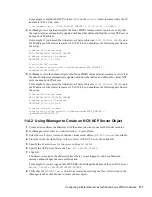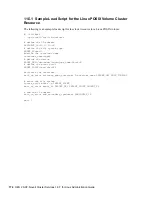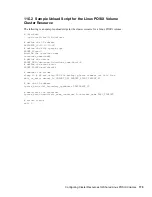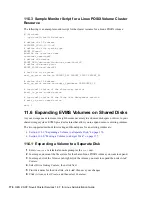
162
OES 2 SP2: Novell Cluster Services 1.8.7 for Linux Administration Guide
no
vd
ocx
(e
n)
7 Ja
nua
ry 201
0
3b
On the Make File System page, choose a Linux POSIX file system interface module from
the list (such as
Ext2/3 File System Interface Module
), then click
Next
.
3c
Specify a volume label, click
Make
, then click
OK
.
3d
Click
Save
, then click
Save
again to save your changes.
The file system type is now listed under the
Plugin
column.
4
Mount the volume:
4a
On the Volumes page, right-click the volume, then select
Mount
.
4b
On the Mount File System page, select the volume, then specify the Linux path to use for
the mount point, such as
/mnt/mount_point
.
4c
(Optional) Click
Options
, specify any desired mount options, then click
OK
.
4d
Click
Mount
, then click
OK
.
The mount point now appears in the
Mount Point
column.
5
Continue with
Section 11.3, “Cluster-Enabling a Linux POSIX Volume on a Shared Disk,” on
page 162
.
11.3 Cluster-Enabling a Linux POSIX Volume on
a Shared Disk
In order to cluster-enable the Linux POSIX volume that you created in
Section 11.2, “Creating
Linux POSIX Volumes on Shared Disks,” on page 158
, you must create a cluster resource for it. The
cluster resource allows the shared disk and its contents to be moved or mounted on different servers
in the cluster. The cluster resource provides a way for clients to automatically reconnect to the
volume regardless of which server is hosting it.
IMPORTANT:
You can create an NCP (NetWare
®
Core Protocol
TM
) volume on the shared Linux
POSIX volume and cluster-enable the shared NCP volume. For information, see “
Configuring NCP
Volumes with Novell Cluster Services
” in the
OES 2 SP2: NCP Server for Linux Administration
Guide
.
EVMS containers are the unit of failover for Linux POSIX volumes. Because the EVMS container
is the unit of failover, all volumes in a container also fail over, but only the volumes that are
mounted through the cluster resource load script are automatically mounted on failover. Any
volumes in the container that are not mounted through the resource load script must be mounted
manually.
Perform the tasks in this section to create and configure a new cluster resource. You can modify the
cluster resource settings afterwards by using the
Clusters > Cluster Options > Properties
option in
iManager.
Section 11.3.1, “Logging in to iManager,” on page 163
Section 11.3.2, “Creating a Cluster Resource for a Linux POSIX Volume,” on page 163
Section 11.3.3, “Configuring a Load Script for a Linux POSIX Volume Cluster Resource,” on
page 164
Section 11.3.4, “Configuring an Unload Script for a Linux POSIX Volume Cluster Resource,”
on page 165






























